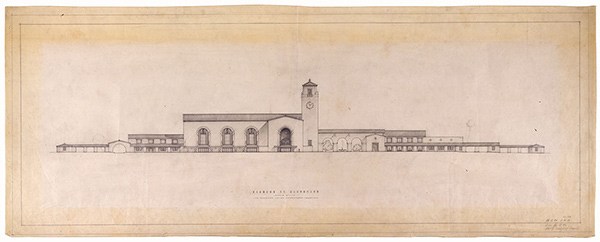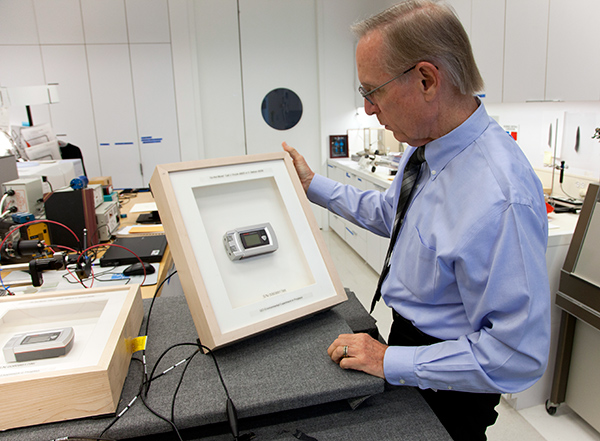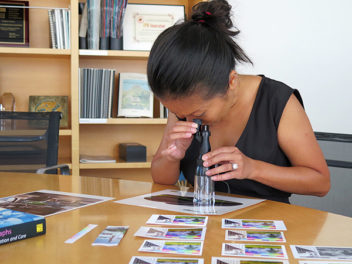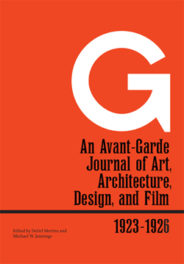
Getty Conservation Institute scientist Vincent Beltran testing dataloggers that will monitor conditions of the microclimate inside frames. Photo: S. Warren
If you live in Southern California, you know about the Santa Ana winds. For the uninitiated, the opening paragraph from Raymond Chandler’s Red Wind (1938) pretty much says it all:
“There was a desert wind blowing that night. It was one of those hot dry Santa Anas that come down through the mountain passes and curl your hair and make your nerves jump and your skin itch. On nights like that every booze party ends in a fight. Meek little wives feel the edge of the carving knife and study their husbands’ necks. Anything can happen. You can even get a full glass of beer at a cocktail lounge.”

Santa Ana winds sweep in from the desert, bringing bone-dry conditions to Southern California
The winds can last for several days. With relative humidity often less that 10%, it is not just our nerves and skin that have the potential to be affected. Could Santa Ana conditions pose a higher-than-normal risk to important archival materials that have been put on display in a gallery without a climate-control system? What is the possibility of sudden or cumulative damage to fragile materials? Would there be buckling, curling, tearing, or fracture in brittle media?
These were questions brought to scientists Vincent Beltran and Jim Druzik at the Getty Conservation Institute. The Getty Research Institute was in the planning stages for an exhibition in the Getty Gallery in Los Angeles Public Library’s Central Library in downtown Los Angeles. Previous exhibitions curated by Research Institute at the Central Library had relied on facsimiles of archival materials in their collections because the gallery lacked a climate-control system. For this exhibition on Los Angeles Union Station, coinciding with the 75th anniversary of its opening, curators wanted to use the original materials from the Research Institute’s Union Station archive. It would be the first time these materials, including architectural drawings, sketches, and photographs documenting the design process of this iconic Los Angeles building, would be on view to the public.

Alameda Street Elevation, Los Angeles Union Passenger Terminal, July 16, 1936, Donald Parkinson and John Parkinson. 25 5/8 x 65 1/8 in. The Getty Research Institute, 990035
While it was expected that the archival materials on display would be protected from the extreme weather conditions resulting from Santa Ana winds by their sealed frames, there was limited scientific data to support this. To fill this information gap, Vincent and Jim set up experiments to determine the buffering effects of specially designed frames in low-humidity conditions.
Wooden frames were constructed in a fashion similar to what might be used in a museum gallery. In one display case a silica gel was also inserted between the mat and filler to control humidity by absorbing or desorbing moisture in response to shifts in humidity. Dataloggers were included to monitor the microclimate inside the frames. The frames were then exposed over several days to simulated Santa Ana conditions and fluctuating humidity levels in the Conservation Institute’s accelerated aging laboratory.

Scientist Jim Druzik in the lab with an assembled frame. Photo: S. Warren
Results from these experiments provided evidence that the sealed frames (with or without the silica gel) could in most cases buffer against low-humidity conditions. It was also noted that even in the event of Santa Ana conditions that lasted for several days, the environmental condition of the gallery would be buffered by the architecturally massive building. Also, the adjacent conditioned spaces within the library would affect the environment of the gallery.
When you are next downtown, stop by the Central Library and see the original materials on exhibit. No Further West: The Story of Los Angeles Union Station opens May 2 and is on view through August 10, 2014. You may not see them, but the dataloggers are there as well and will continue to monitor the environmental condition of the gallery, providing additional information for Conservation Institute scientist to analyze.

Installation in progress for No Further West at the Central Library
Studies such as this one are part of the Conservation Institute’s work to better understand the response of materials—especially those that easily absorb moisture from the atmosphere—to fluctuations in climate at both the micro and macro scale. Laboratory research, together with studies in the field, will generate the data that will more precisely identify conditions under which irreversible damage occurs to our treasured objects. This work is part of a larger Getty Conservation Institute initiative, Managing Collection Environments, which focuses on issues relating to sustainable collection environments.




There is no such thing as “Santa Ana” winds. Santa Ana winds are a mispronunciation of Santana winds. The translation of Santana wind is “Devil wind” referring to the hot and dry nature of the air itself. Santana winds are usually out of the south for Southern California and are hot and dry.